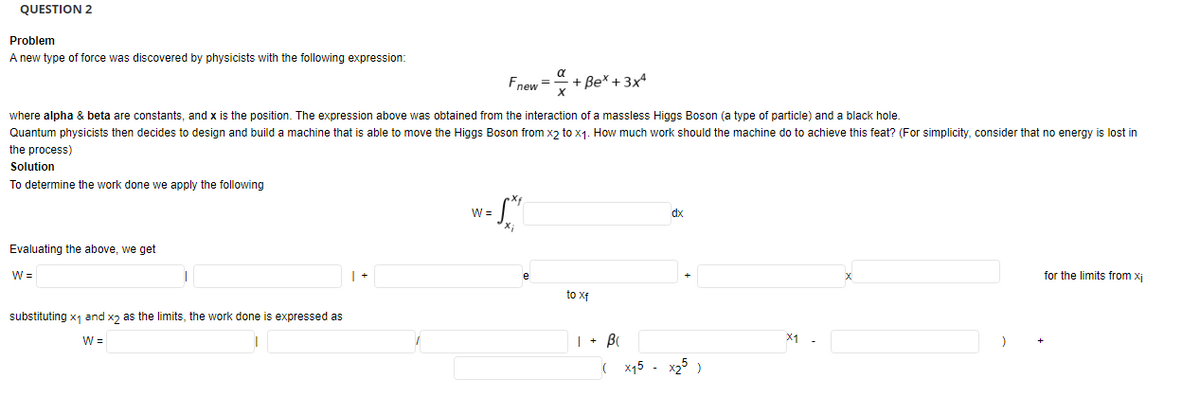Fnew =+ Problem A new type of force was discovered by physicists with the following expression: a + Be* + 3xª %3D where alpha & beta are constants, and x is the position. The expression above was obtained from the interaction of a massless Higgs Boson (a type of particle) and a black hole. Quantum physicists then decides to design and build a machine that is able to move the Higgs Boson from x2 to x1. How much work should the machine do to achieve this feat? (For simplicity, consider that no energy is lost in the process) Solution To determine the work done we apply the following W = dx Evaluating the above, we get W= for the limits from xị to xf substituting x1 and x2 as the limits, the work done is expressed as W = X1 . ( x15 - x25 )
Fnew =+ Problem A new type of force was discovered by physicists with the following expression: a + Be* + 3xª %3D where alpha & beta are constants, and x is the position. The expression above was obtained from the interaction of a massless Higgs Boson (a type of particle) and a black hole. Quantum physicists then decides to design and build a machine that is able to move the Higgs Boson from x2 to x1. How much work should the machine do to achieve this feat? (For simplicity, consider that no energy is lost in the process) Solution To determine the work done we apply the following W = dx Evaluating the above, we get W= for the limits from xị to xf substituting x1 and x2 as the limits, the work done is expressed as W = X1 . ( x15 - x25 )
Physics for Scientists and Engineers: Foundations and Connections
1st Edition
ISBN:9781133939146
Author:Katz, Debora M.
Publisher:Katz, Debora M.
Chapter7: Gravity
Section: Chapter Questions
Problem 68PQ
Related questions
Question
Kindly add labels and boxes for the final answer. Thank you.

Transcribed Image Text:QUESTION 2
Problem
A new type of force was discovered by physicists with the following expression:
a
Fnew =
+ Bex + 3x4
where alpha & beta are constants, and x is the position. The expression above was obtained from the interaction of a massless Higgs Boson (a type of particle) and a black hole.
Quantum physicists then decides to design and build a machine that is able to move the Higgs Boson from xɔ to x1. How much work should the machine do to achieve this feat? (For simplicity, consider that no energy is lost in
the process)
Solution
To determine the work done we apply the following
W =
dx
Evaluating the above, we get
W =
for the limits from xj
to xf
substituting x1 and xɔ as the limits, the work done is expressed as
W =
| + B
( x15 - x25)
Expert Solution
This question has been solved!
Explore an expertly crafted, step-by-step solution for a thorough understanding of key concepts.
Step by step
Solved in 2 steps

Recommended textbooks for you

Physics for Scientists and Engineers: Foundations…
Physics
ISBN:
9781133939146
Author:
Katz, Debora M.
Publisher:
Cengage Learning

Physics for Scientists and Engineers with Modern …
Physics
ISBN:
9781337553292
Author:
Raymond A. Serway, John W. Jewett
Publisher:
Cengage Learning

Physics for Scientists and Engineers
Physics
ISBN:
9781337553278
Author:
Raymond A. Serway, John W. Jewett
Publisher:
Cengage Learning

Physics for Scientists and Engineers: Foundations…
Physics
ISBN:
9781133939146
Author:
Katz, Debora M.
Publisher:
Cengage Learning

Physics for Scientists and Engineers with Modern …
Physics
ISBN:
9781337553292
Author:
Raymond A. Serway, John W. Jewett
Publisher:
Cengage Learning

Physics for Scientists and Engineers
Physics
ISBN:
9781337553278
Author:
Raymond A. Serway, John W. Jewett
Publisher:
Cengage Learning

Principles of Physics: A Calculus-Based Text
Physics
ISBN:
9781133104261
Author:
Raymond A. Serway, John W. Jewett
Publisher:
Cengage Learning

College Physics
Physics
ISBN:
9781938168000
Author:
Paul Peter Urone, Roger Hinrichs
Publisher:
OpenStax College

University Physics Volume 1
Physics
ISBN:
9781938168277
Author:
William Moebs, Samuel J. Ling, Jeff Sanny
Publisher:
OpenStax - Rice University